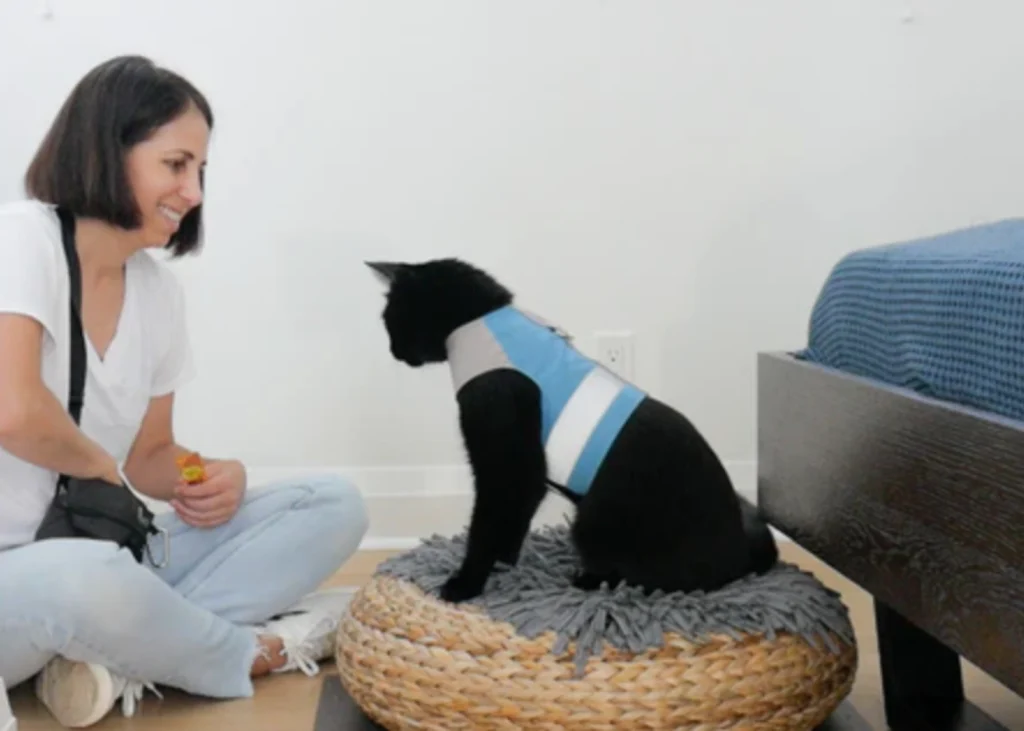The Benefits of Clicker Training for Cats: A Guide to Positive Reinforcement

Unlocking the Potential of Your Feline Friend
Have you ever wondered how to enrich your cat’s life while strengthening your bond? Clicker training offers an effective method to communicate with your pet and encourage desired behaviors. This technique, rooted in positive reinforcement, is not just for dogs; it can be a game-changer for your feline companion. With the right approach, you can tap into your cat’s natural instincts and curiosity, turning training sessions into both fun and educational experiences.
What is Clicker Training?
Clicker training is a system of communication that utilizes a small device that makes a distinct clicking sound. This sound acts as a marker, letting your cat know they’ve performed a desired action. When paired with a treat, the click builds an association in your cat’s mind between the sound and a reward. Over time, this training method can help your kitty learn everything from basic commands like ‘sit’ and ‘stay’ to more complex tricks like ‘high-five’ and even agility training.
Benefits of Clicker Training
Consider the following benefits of clicker training:
- Enhances Communication: The click sound creates a clear channel for interaction between you and your cat. Cats can be enigmatic creatures, and this training method provides a structured language that they can understand.
- Builds Trust: Clicker training emphasizes positive interactions, which can strengthen the human-animal bond through enjoyable experiences. Imagine your cat’s confidence as they learn to trust that good behavior leads to rewards!
- Reduces Behavioral Issues: This technique can effectively redirect unwanted behaviors, such as scratching furniture or excessive vocalization. By rewarding appropriate actions, you’re teaching your pet what to do instead.
Getting Started with Clicker Training
To embark on your journey with clicker training, begin by selecting a quiet space free from distractions. The initial step is to familiarize your cat with the clicker. Click it once, then immediately offer a treat. Repeat this several times until your cat associates the sound with a positive outcome. Once this connection is made, you can start introducing commands or simple tricks.
Training sessions should be kept short and engaging, ideally lasting no longer than 5 to 10 minutes. Regular practice not only reinforces learning but also helps maintain your cat’s interest. Consider incorporating various activities, like using toys in tricks or involving family members, to keep the experiences diverse and stimulating.

In this guide, you’ll uncover the numerous advantages of implementing clicker training for your cat. This method empowers you to shape your pet’s behavior in a fun and interactive way. Get ready to transform training sessions into an enjoyable routine that benefits both you and your furry friend. So grab a clicker and some treats—your journey towards a better understanding of your feline companion begins now!
DISCOVER MORE: Click here for financial resources on pet adoption
Understanding the Psychology Behind Clicker Training
When we think about training our pets, many of us instantly picture dogs following commands and performing tricks. However, clicker training for cats is gaining recognition as a highly effective method to engage and stimulate our feline friends. Understanding the psychology behind this method reveals why it works so well with cats, who are often perceived as independent and aloof.
At its core, clicker training leverages the principles of behavioral psychology. The technique is based on operant conditioning, a learning process where behaviors are influenced by their consequences. By associating a specific behavior with immediate positive reinforcement—in this case, the click sound followed by a treat—cats are more likely to repeat that behavior in the future. This method taps into their natural instincts of exploration and play, turning training into an enriching adventure.
The Role of Timing and Consistency
One of the key factors in successful clicker training is timing. The click sound must occur immediately after the desired behavior is performed to create a strong association in your cat’s mind. If you take too long to click, your cat might not connect the sound with the action you want to reinforce. For this reason, practicing good timing is crucial during training sessions.
In addition to timing, consistency is paramount. Using the same command and clicker sound for particular behaviors helps your cat learn faster. For instance, if you’re teaching your cat to ‘jump,’ consistently using the word ‘jump’ along with the click sound will build a strong association. This consistency leads to more effective training sessions, ensuring your cat understands what is expected of them.
Building a Variety of Skills
Clicker training is not just limited to teaching basic commands. The method can be applied to a wide range of skills and behaviors. Consider the following areas where clicker training can shine:
- Basic Commands: Start with fundamental commands like ‘sit,’ ‘come,’ and ‘stay’ to establish the groundwork for your training sessions.
- Tricks: Once your cat has mastered the basics, you can introduce fun tricks such as ‘high-five’ or ‘roll over,’ which can spark interest and excitement during training.
- Behavior Modification: Utilize clicker training to reduce undesirable behaviors such as jumping on counters or excessive meowing by rewarding alternative actions.
By applying clicker training across multiple areas, you not only improve your cat’s behavior but also engage their mind, providing mental stimulation that is essential for their well-being.
In the subsequent sections of this guide, we’ll dive deeper into specific techniques and advanced methods that can help you harness the full potential of clicker training for your cat. Stay tuned as we explore how to further enhance your feline friend’s abilities while reaffirming your bond through shared learning experiences!
| Category | Description |
|---|---|
| Enhanced Communication | Clicker training establishes a clear method of communication between the cat and owner, ensuring that the desired behaviors are easily recognized. |
| Increased Engagement | This technique stimulates mental activity in cats, making training sessions engaging and rewarding, which can lead to improved behavior overall. |
| Positive Association | With clicker training, cats learn to associate good behavior with positive rewards, thus promoting a healthier training environment. |
| Behavior Modification | This method can effectively modify adverse behaviors by positively reinforcing alternative actions, leading to a happier pet. |
Clicker training not only improves communication and understanding but also enhances the bond between feline and owner through shared experiences. The method is scientifically rooted in behavior psychology, ensuring that cats respond brilliantly to structured approaches. By incorporating this training into daily life, pet owners can witness a noticeable transformation in their pets, making even the most stubborn cats succeed in learning various commands and behaviors. Moreover, the interactive nature of clicker training turns each session into a fun opportunity for both the cat and the trainer, solidifying trust and affection. Explore the dynamic world of clicker training and discover how this positive reinforcement technique can unlock your cat’s potential.
DISCOVER MORE: Click here to learn about nutritional supplements for your pet
Enhancing the Human-Cat Bond Through Clicker Training
One of the most significant advantages of clicker training for cats lies in its ability to strengthen the bond between you and your feline companion. Training sessions offer dedicated time together, fostering a sense of trust and understanding that may not be achieved through casual interactions alone. As your cat learns new behaviors and tricks, they begin to recognize you as a source of guidance and support, enhancing your mutual relationship.
The Importance of Positive Interaction
Clicker training shifts the paradigm from traditional discipline methods to a framework of positive interaction. Instead of focusing on reprimanding unwanted behaviors, you redirect your cat’s actions by offering them rewards for desirable conduct. This positive reinforcement method is particularly impactful on how your cat perceives training and your presence. A cat that associates you with fun, rewards, and play is more likely to respond positively during training sessions.
Research supports the effectiveness of positive reinforcement in building a more enjoyable training atmosphere. A study featured in the Journal of Veterinary Behavior indicates that animals trained through positive methods display lower stress levels and higher resilience to training, making them more eager learners. This positive feedback loop not only benefits the training experience but also deepens the connection you share with your pet.
Increasing Mental and Physical Stimulation
Another noteworthy benefit of clicker training is its potential to provide both mental and physical stimulation. Cats, by nature, are highly inquisitive creatures. Engaging them in clicker training can help fulfill their need for mental challenges, thus avoiding boredom-induced behaviors, which are often undesirable.
For example, teaching your cat to navigate an obstacle course using clicker training can offer extensive mental stimulation while providing physical exercise. Creating such setups stimulates their natural hunting and exploratory instincts, resulting in both physical fitness and cognitive engagement. This combination is vital for indoor cats that may not have as many opportunities for natural behaviors compared to their outdoor counterparts.
Real-World Applications: Training for Safety
Clicker training is not solely about fun tricks; it can also play a vital role in ensuring your cat’s safety. For instance, teaching your cat to respond to commands like ‘come’ can save them from dangerous situations, whether indoors or outdoors. By using the clicker method to reinforce these instructions, you ensure that the learning process is effective and enjoyable for your pet, helping to solidify these critical behaviors.
Moreover, clicker training can aid in acclimating your cat to new environments or experiences. This is especially important for cats that may feel anxious or stressed during excursions to the veterinarian or when traveling. Reinforcing calm behavior with clicks can help transform potentially distressing situations into manageable experiences, ultimately promoting a peaceful demeanor.
All these elements of clicker training not only encourage your cat to behave in desirable ways but also cultivate an environment rich in positive interactions, trust, and mutual respect. As you continue to explore the realms of clicker training for cats, you will discover additional benefits that resonate with the idea of fostering a harmonious relationship with your furry friend.
LEARN MORE: Click here to discover the importance of balanced nutrition for your pet’s health
Conclusion: Embracing Clicker Training for a Happier Cat
In summary, the benefits of clicker training for cats extend far beyond mere obedience; they encapsulate a holistic approach to enhancing the human-animal relationship. This innovative method of positive reinforcement fosters not only a deeper bond of trust between you and your cat but also promotes mental stimulation and physical activity, essential elements for any indoor cat’s well-being. As your feline friend engages in learning new tricks and behaviors, they receive the mental challenges and physical exercise they need to thrive, effectively curtailing undesirable behaviors that often arise from boredom or stress.
Additionally, clicker training serves as an invaluable tool in promoting safety and confidence in your cat. By instilling responsive behaviors to commands, you take proactive steps to protect your pet in potentially risky situations, whether indoors or outdoors. Moreover, helping your cat acclimate to new experiences through positive reinforcement can significantly ease anxiety related to travel or veterinary visits, making these moments less daunting for both of you.
As a cat owner, embracing the principles of clicker training is not just a commitment to teaching your pet but a journey toward creating a fulfilling and enriched life for your feline companion. Explore the various techniques and applications discussed in this guide, and consider delving deeper into the research that supports the efficacy of positive reinforcement. Your cat deserves a life filled with joy, engagement, and safety—clicker training is a powerful step in achieving that goal.


